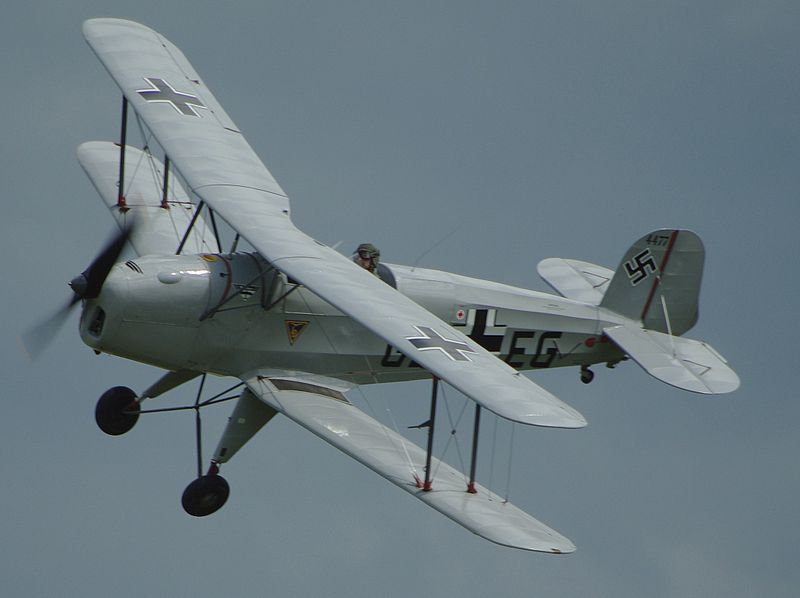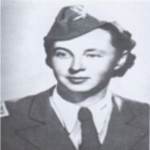
Bücker Bü 131 (Jungmann)
The German Bücker Bü 131 “Jungmann” (Young man) was a 1930s basic training aircraft which was used by the Luftwaffe during World War II.
About Bücker Bü 131 (Jungmann) – Source Wikipedia
Role: Basic trainer
Manufacturer: Bücker Flugzeugbau
Designer: Carl Bücker
First flight: 27 April 1934
Introduction: 1935 (Luftwaffe)
Status: Retired in 1968 (Spanish Air Force)
Primary users: Luftwaffe, Spanish Air Force, Imperial Japanese Army Air Service,
Variants: Bü 133 Jungmeister
Specifications (Bü 131B)
Data from Jane’s Fighting Aircraft of World War II
General characteristics
- Crew: Two (student and instructor)
- Length: 6.62 m (21 ft 8 in)
- Wingspan: 7.40 m (24 ft 3 in)
- Height: 2.35 m (7 ft 6 in)
- Wing area: 13.5 m² (145 ft²)
- Empty weight: 380 kg (840 lb)
- Loaded weight: 670 kg (1,500 lb)
- Powerplant: 1 × Hirth HM 504 four-cylinder inverted inline engine, 70 kW (100 hp)
Performance
- Maximum speed: 183 km/h (99 kn, 115 mph)
- Cruise speed: 170 km/h (92 kn, 110 mph)
- Range: 628 km (339 nm, 390 mi)
- Service ceiling: 4,050 m (13,300 ft)
- Rate of climb: 2.8 m/s (6,600 ft)
- Wing loading: 46.3 kg/m² (9.49 lb/ft²)
- Power/mass: 100 W/kg (0.064 hp/lb)

Bücker Bü 131 (Jungmann)
The German Bücker Bü 131 “Jungmann” (Young man) was a 1930s basic training aircraft which was used by the Luftwaffe during World War II.
Development
After serving in the Kaiserliche Marine in World War I, Carl Bücker moved to Sweden where he became managing director of Svenska Aero AB (Not to be confused with Svenska Aeroplan AB, SAAB). He later returned to Germany with Anders J Andersson, a young designer from SAAB. Bücker Flugzeugbau GmbH was founded in Berlin-Johannistahl, in 1932, with the first aircraft to see production being the Bü 131 Jungmann.
Bücker Flugzeugbau’s first production type, the Bü 131A was the last biplane built in Germany. It had two open cockpits in tandem and fixed landing gear. The fuselage was steel tube, covered in fabric and metal, the wings wood and fabric. It first flew on the 80 hp (60 kW) Hirth HM60R.
In 1936, it was followed by the Bü 131B, with a 105 hp (78 kW) Hirth 504A-2.
Most wartime production for the Luftwaffe was by Aero in Prague.
Operational history
Sturdy and agile, the Bü 131A was first delivered to the Deutscher Luftsportverband (DLV). The Bü 131B was selected as the primary basic trainer for the German Luftwaffe, and it served with “virtually all” the Luftwaffe’s primary flying schools during the war, as well as with night harassment units such as Nachtschlacht Gruppen (NSGr) 2, 11, and 12. Yugoslavia was the main prewar export customer; “as many as 400 may have found their way” there. She was joined by Bulgaria with 15 and Rumania with 40.
Production licenses were granted to Switzerland (using 94, 88 built under licence to Dornier), Spain (building about 530), Hungary (which operated 315), Czechoslovakia (10, as the Tatra T 131, before war began), and Japan, the last of which built 1,037 for Army with Hatsukaze power as the Kokusai Ki-86 and 339 for the Navy Air Services as the Kyushu K9W. In Spain, production continued at CASA until the early 1960s. The Jungmann was retained as the Spanish Air Force’s primary basic trainer until 1968.
About 200 Jungmanns survive to this day, many having been fitted with modern engines. In 1994, the Bü 131 was restored to production briefly using CASA jigs by Bücker Prado in Spain, with 21 aircraft constructed as the BP 131, while SSH Janusz Karasiewicz in Poland also started production of a version of the Jungmann based on Czech plans in 1994.
Variants
Bü 131A
Two-seat primary trainer biplane. Initial production version.
Bü 131B
Improved version, powered by the more powerful Hirth HM 504A-2 piston engine.
Bü 131C
Experimental version, fitted with 67 kW (90 hp) Cirrus Minor piston engine. One built.
Nippon Kokusai Ki-86A
apanese production version for the Imperial Japanese Army Air Service. Powered by a Hitachi Ha-47
Nippon Kokusai Army Type 4 Primary Trainer
The long designation for the Ki-86A
Nippon Kokusai Ki-86B
An all-wooden airframe version to relieve scarce supplies of strategic materials.
Kyushu K9W1 Momiji
Japanese production version for the Imperial Japanese Navy. Poewered by the Hitachi GK4A Hatsukaze 11
Kyushu Navy Type 2 Trainer Model 11
The long designation for the Kyushu K9W1
Tatra T.131
Czechoslovakia, pre-war licence production in Tatra Koprivnice.
Aero C-4
Mass-produced in Aero factory in occupied Czechoslovakia during wartime under original Bücker Bü 131B designation, used postwar with original Hirth engine.
Aero C-104
Czechoslovakia, postwar development with a Walter Minor 4-III engine, 260 aircraft built.
CASA 1.131
Spanish license-built versions
BP 131
Modern license-built version
SSH T-131P
Pre-production modern Polish version, powered by 78 kW (105 hp) Walter Minor 4-III engine. Four built from 1994.
SSH T-131PA
Main Polish production version, with 103 kW (138 hp) LOM M332AK engine. First flew 1995.

Bücker Bü 131 (Jungmann)
The German Bücker Bü 131 “Jungmann” (Young man) was a 1930s basic training aircraft which was used by the Luftwaffe during World War II.






